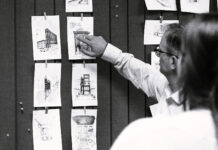CAM’s television and radio broadcast production facilities have also been outfitted with the latest technologies and construction features specific for their use.
On the radio side, “it’s not a broadcast station; it’s internet only. Radio broadcasting licenses are hard to come by and really expensive,” says Clark.
Radio SLCC has space in CAM larger than what it was in the Technology Building at Taylorsville Redwood Campus, and it is set up for two different functions. One is for live production and recording for interviews, production, small groups to be put onto the air, according to Clark.
“And the other side is live air radio,” and large enough to put four or five people on the air in lieu of only two as before, added Clark.
Tyler Smith, assistant professor in Communication, who teaches television and documentary film production classes, was among those whose programs relocated from Taylorsville Redwood to South City Campus.
“We are excited to have state of the art, high definition television production equipment to give students a workflow opportunity that will be represented in a workplace,” says Smith. “It’s going to be the best production facility that students can use in the state. It is an absolutely amazing studio that students will really get their hands on the equipment.”
The production switcher for the television broadcast control room is a Ross Vision series, according to Jon Clark. Ross Video Ltd., is based in Ontario, Canada.

“With the Ross system we have here, a student can walk from that and go to a state of the art broadcast facility in New York, or a broadcast truck, and they would see the same kind of equipment being used every day to do network productions,” says Clark.
Combined with the studio set up, students also have hands-on access to use high definition, broadcast quality cameras, sound and lighting equipment and other accessory equipment that can be checked out for projects.
Attention to construction features for the spaces was as intentional as for the music recording studios. The television broadcast control room, with a separate audio control room, and the filming floor are visually connected by a glass vision panel, unusual in the industry, according to Clark. The purpose of these rooms is for teaching classes and producing high quality work.
“The floors, for example, are concrete floors but are a super flat floor, so the cameras would not roll in those areas. This way, there is no reflection of any floor imperfections in the video process,” says Bob Askerlund, assistant vice president of Facilities Services. “The technology electronics side of it, very very high watts per square foot. If you look at the lighting configuration capability, it is almost unlimited from a lighting and power standpoint.”
The television and film production spaces feature access from the outside by large and acoustically-treated overhead doors. The large spaces, designed for quick changes of scenery sets, are outfitted with hoists to pull scenery or lights in the air via chains.
This is “so large props could be brought in, vehicles, things like that,” says Askerlund. “There are not a lot of spaces around that have that capability, to be able to drive into the studio.”
Collectively, the entire design of the facilities has garnered interest from local television stations that are wishing to bring productions to the CAM for student opportunities in production.






